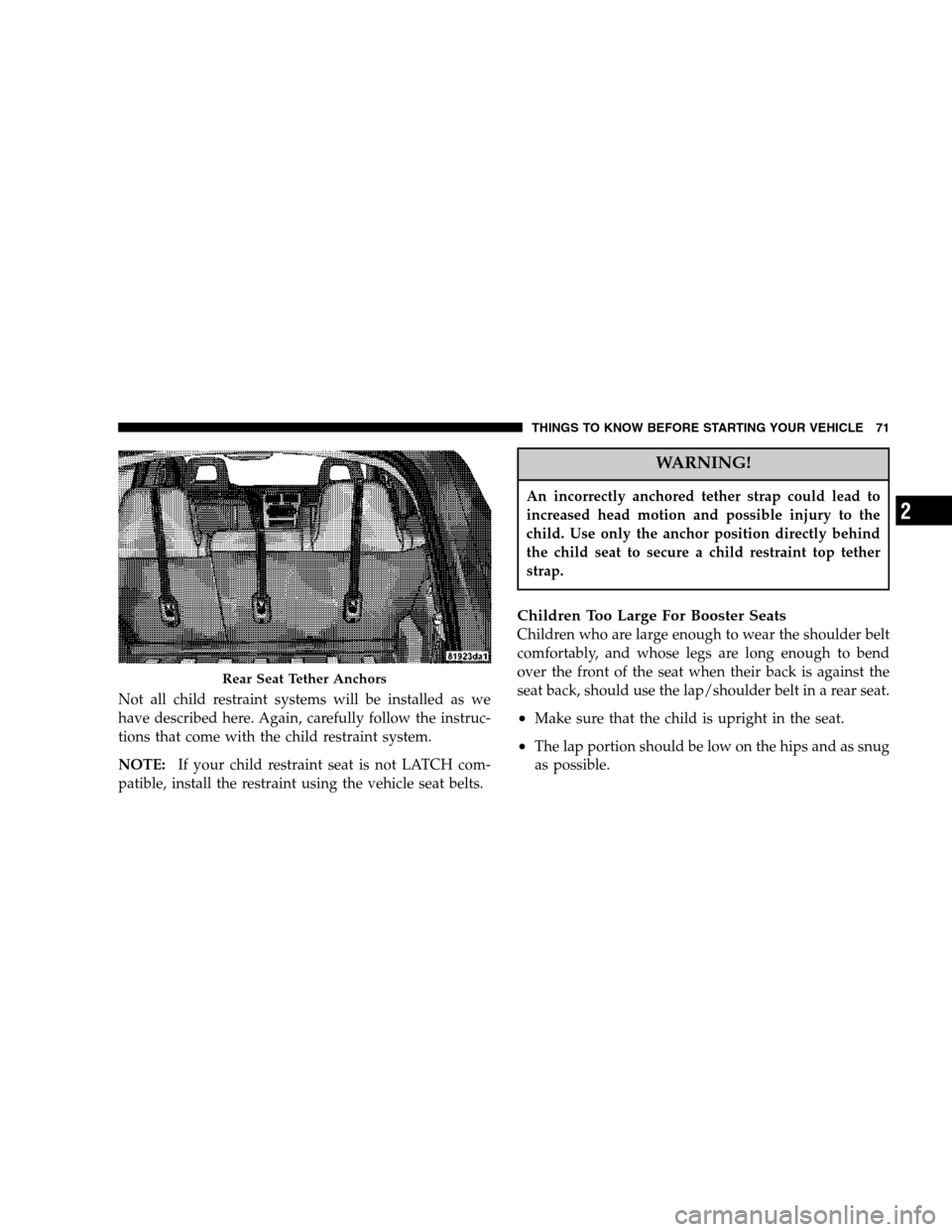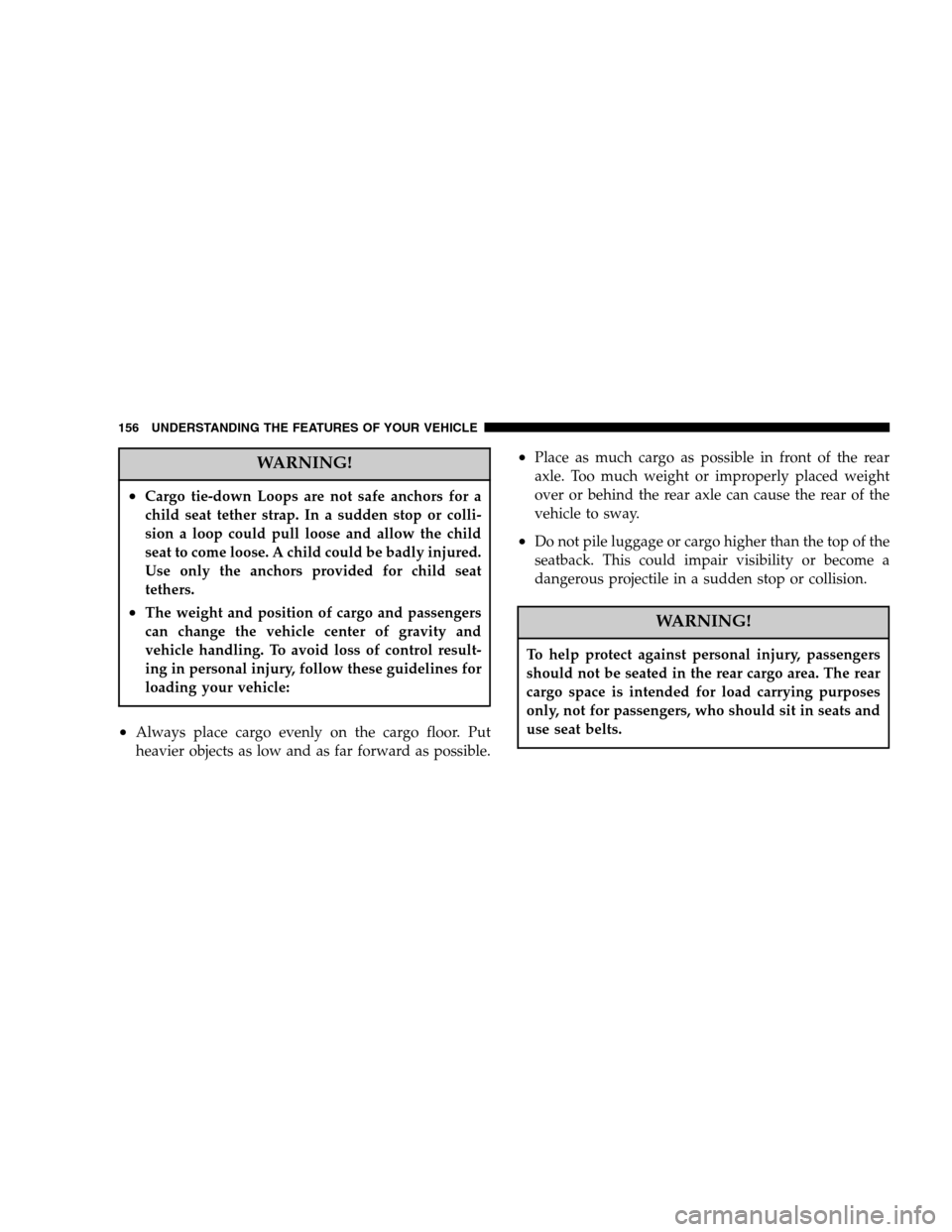2007 JEEP COMPASS child seat
[x] Cancel search: child seatPage 70 of 408

NOTE:When using the LATCH attaching system to
install a child restraint, please ensure that all seat belts
not being used for occupant restraints are stowed and out
of reach of children. It is recommended that before
installing the child restraint, buckle the seat belt so the
seat belt is tucked behind the child restraint and out of
reach. If the buckled seat belt interferes with the child
restraint installation, instead of tucking the seat belt
behind the child restraint, route the seat belt through the
child restraint belt path and then buckle it. This should
stow the seat belt out of the reach of an inquisitive child.
Remind all children in the vehicle that the seat belts are
not toys and should not be played with, and never leave
your child unattended in the vehicle.Installing the Child Restraint System
We urge that you carefully follow the directions of the
manufacturer when installing your child restraint. Many,
but not all, restraint systems will be equipped with
separate straps on each side, with each having a hook or
connector and a means for adjusting the tension in the
strap. Forward-facing toddler restraints and some
rearward-facing infant restraints will also be equipped
with a tether strap with a hook and means for adjusting
the tension in the strap.
In general, you will first loosen the adjusters on the lower
and tether straps so that you can more easily attach the
hook or connector to the lower and tether anchorages.
The tether strap should be routed under the center of the
head restraint and attached to the tether anchor on the
rear of the seat back. Then tighten all three straps as you
push the child restraint rearward and downward into the
seat.
70 THINGS TO KNOW BEFORE STARTING YOUR VEHICLE
Page 71 of 408

Not all child restraint systems will be installed as we
have described here. Again, carefully follow the instruc-
tions that come with the child restraint system.
NOTE:If your child restraint seat is not LATCH com-
patible, install the restraint using the vehicle seat belts.
WARNING!
An incorrectly anchored tether strap could lead to
increased head motion and possible injury to the
child. Use only the anchor position directly behind
the child seat to secure a child restraint top tether
strap.
Children Too Large For Booster Seats
Children who are large enough to wear the shoulder belt
comfortably, and whose legs are long enough to bend
over the front of the seat when their back is against the
seat back, should use the lap/shoulder belt in a rear seat.
•Make sure that the child is upright in the seat.
•The lap portion should be low on the hips and as snug
as possible.
Rear Seat Tether Anchors
THINGS TO KNOW BEFORE STARTING YOUR VEHICLE 71
2
Page 72 of 408

•Check belt fit periodically. A child’s squirming or
slouching can move the belt out of position.
•If the shoulder belt contacts the face or neck, move the
child closer to the center of the vehicle. Never allow a
child to put the shoulder belt under an arm or behind
their back.
Transporting Pets
Airbags deploying in the front seat could harm your pet.
An unrestrained pet will be thrown about and possibly
injured, or injure a passenger during panic braking or in
a collision.
Pets should be restrained in the rear seat in pet harnesses
or pet carriers that are secured by seat belts.
ENGINE BREAK-IN RECOMMENDATIONS
A long break-in period is not required for the engine in
your new vehicle.
Drive moderately during the first 300 miles (500 km).
After the initial 60 miles (100 km), speeds up to 50 or 55
mph (80 or 90 km/h) are desirable.
While cruising, brief full-throttle acceleration, within the
limits of local traffic laws, contributes to a good break-in.
Wide open throttle acceleration in low gear can be
detrimental and should be avoided.
The engine oil installed in the engine at the factory is a
high quality energy conserving type lubricant. Oil
changes should be consistent with anticipated climate
conditions under which vehicle operations will occur.
The recommended viscosity and quality grades are
shown in Section 7 of this manual. NON-DETERGENT
OR STRAIGHT MINERAL OILS MUST NEVER BE
USED.
72 THINGS TO KNOW BEFORE STARTING YOUR VEHICLE
Page 147 of 408

WARNING!
•Never leave children in a vehicle, with the keys in
the ignition switch. Occupants, particularly unat-
tended children, can become entrapped by the
power sunroof while operating the power sunroof
switch. Such entrapment may result in serious
injury or death.
•In an accident, there is a greater risk of being
thrown from a vehicle with an open sunroof. You
could also be seriously injured or killed. Always
fasten your seat belt properly and make sure all
passengers are properly secured too.
•Do not allow small children to operate the sun-
roof. Never allow fingers or other body parts, or
any object to project through the sunroof opening.
Injury may result.
OPENING SUNROOF – MANUAL
To open the sunroof, press and hold the switch rearward
to full open. Any release of the switch will stop the
movement and the sunroof will remain in a partial open
condition until the switch is pushed and held rearward
again.
OPENING SUNROOF – EXPRESS MODE
Press the switch rearward and release, and the sunroof
will open automatically from any position. The sunroof
will open fully, the stop automatically. This is called
Express Open. During Express Open operation, any
movement of the sunroof switch will stop the sunroof.
CLOSING SUNROOF – MANUAL
To close the sunroof, press and hold the switch in the
forward position. Again, any release of the switch will
stop the movement and the sunroof will remain in a
partial close condition until the switch is pushed and
UNDERSTANDING THE FEATURES OF YOUR VEHICLE 147
3
Page 156 of 408

WARNING!
•Cargo tie-down Loops are not safe anchors for a
child seat tether strap. In a sudden stop or colli-
sion a loop could pull loose and allow the child
seat to come loose. A child could be badly injured.
Use only the anchors provided for child seat
tethers.
•The weight and position of cargo and passengers
can change the vehicle center of gravity and
vehicle handling. To avoid loss of control result-
ing in personal injury, follow these guidelines for
loading your vehicle:
•Always place cargo evenly on the cargo floor. Put
heavier objects as low and as far forward as possible.
•Place as much cargo as possible in front of the rear
axle. Too much weight or improperly placed weight
over or behind the rear axle can cause the rear of the
vehicle to sway.
•Do not pile luggage or cargo higher than the top of the
seatback. This could impair visibility or become a
dangerous projectile in a sudden stop or collision.
WARNING!
To help protect against personal injury, passengers
should not be seated in the rear cargo area. The rear
cargo space is intended for load carrying purposes
only, not for passengers, who should sit in seats and
use seat belts.
156 UNDERSTANDING THE FEATURES OF YOUR VEHICLE
Page 232 of 408

STARTING PROCEDURES
Before starting your vehicle, adjust your seat, adjust both
inside and outside mirrors, and fasten your seat belts.
WARNING!
Never leave children alone in a vehicle. Leaving
children in a vehicle unattended is dangerous for a
number of reasons. A child or others could be
seriously or fatally injured. Don’t leave the keys in
the ignition. A child could operate power windows,
other controls, or move the vehicle.
WARNING!
Be sure to turn off the engine if you want to rest or
sleep in your car. Accidents can be caused by inad-
vertently moving the gear selection lever or by
pressing the accelerator pedal. This may cause exces-
sive heat in the exhaust system, resulting in over-
heating and vehicle fire which may cause serious or
fatal injuries.
Automatic Transaxle
The gear selector must be in the PARK or NEUTRAL
position before you can start the engine. Apply the brakes
before shifting to any driving gear.
NOTE:You must press the brake pedal before shifting
out of Park.
232 STARTING AND OPERATING
Page 394 of 408

CD (Compact Disc) Player...............187,195
CD (Compact Disc) Player Maintenance........ 219
Cellular Phone........................ 83,220
Center High Mounted Stop Light............ 361
Chains, Tire............................ 275
Changing A Flat Tire..................... 301
Chart, Tire Sizing........................ 252
Check Engine Light
(Malfunction Indicator Light)............... 318
Child Restraint.......................... 64
Child Restraint Tether Anchors............... 68
Child Restraint with Automatic Belts........... 67
Child Safety Locks........................ 23
Child Seat.............................. 70
Clean Air Gasoline....................... 278
Cleaning
Wheels............................. 347
Climate Control......................... 220
Clock ........................186,189,197,210Clutch............................... 340
Clutch Fluid........................... 340
CoinHolder ........................... 152
Compact Disc (CD) Maintenance............. 219
Compact Spare Tire...................... 263
Compass.............................. 184
Compass Calibration..................... 184
Compass Variance....................... 183
Console.............................. 152
Contract, Service........................ 386
Coolant (Antifreeze)...................362,363
Cooling System......................... 333
Adding Coolant (Antifreeze).............. 335
Coolant Level......................334,337
Disposal of Used Coolant................ 336
Drain, Flush, and Refill.................. 334
Inspection........................... 337
Points to Remember.................336,337
Pressure Cap......................... 336
394 INDEX
Page 400 of 408

Seat Belt Reminder..................... 168
Security Alarm (Theft Alarm).............. 32
Theft Alarm (Security Alarm).............. 170
Traction Control....................... 142
Turn Signal.................. 119,122,167,358
Voltage............................. 166
Warning (Instrument Cluster Description)..... 166
Loading Vehicle......................... 284
Tires ............................... 255
Locks
Child Protection........................ 23
Door................................ 18
Power Door........................... 19
Steering Wheel......................... 17
Lubrication, Body....................... 331
Luggage Rack (Roof Rack)................. 159
Lumbar Support........................ 110
Maintenance Free Battery.................. 327Maintenance, General..................... 320
Maintenance Procedures................... 320
Maintenance Schedule.................... 366
Schedule “A”......................... 378
Schedule “B”......................... 369
Malfunction Indicator Light (Check Engine) . . 174,318
Manual, Service......................... 388
Manual Transaxle..................233,241,343
Downshifting......................... 242
Fluid Level Check...................343,344
Frequency of Fluid Change............343,344
Lubricant Selection..................343,344
Map/Reading Lights..................... 118
Master Cylinder (Brakes).................. 340
Mirrors ................................ 79
Electric Powered....................... 81
Outside.............................. 80
Rearview............................. 79
Vanity ............................... 82
400 INDEX